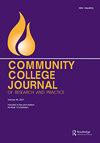“I Thought It Was a Little Risky”: Transfer Barriers for Students with Scholarship Support
IF 0.6
Q3 EDUCATION & EDUCATIONAL RESEARCH
Community College Journal of Research and Practice
Pub Date : 2023-09-29
DOI:10.1080/10668926.2023.2256249
引用次数: 0
Abstract
A study of hidden risks, anxieties and barriers to STEM student transfer from community college to a large, comprehensive university is presented. This qualitative study employed a thematic analysis of student responses to a semi-structured interview that asked students about their hesitancy to transfer to a 4-year institution. Participants included students enrolled in a collaborative NSF-sponsored S-STEM scholarship project between three community colleges and a large public university (all in the same large metropolitan area). The project included elements that are well documented in the literature to encourage transfer. These include advising visits by university staff, clear articulation pathways, scholarship support to assist with costs, peer and near peer mentoring opportunities, and cohort-building activities between campuses and on each individual campus. Transfer rates in this group were higher, but still many students with declared interest in transferring did not transfer on time or at all. The authors identified numerous hidden risks and barriers to transfer, in addition to the well-known ones found in the literature. These include additional academic, financial, social, logistical and external/family related barriers. A theme common to many of these barriers was complex bureaucratic processes and events outside of student’s direct control. Many student comments highlighted the importance of in-person connections, mentoring and advising.“我认为这有点冒险”:获得奖学金支持的学生的转学障碍
研究了STEM学生从社区学院转到大型综合性大学的潜在风险、焦虑和障碍。这项定性研究采用了一个主题分析学生对半结构化访谈的反应,该访谈询问了学生对转学到四年制大学的犹豫。参与者包括参加nsf赞助的S-STEM奖学金项目的学生,该项目由三所社区学院和一所大型公立大学(都在同一个大都市区)共同资助。该项目包括文献中详细记载的鼓励转移的要素。这些措施包括大学工作人员的访问建议、清晰的衔接途径、奖学金支持,以协助支付费用、同侪和近同侪辅导机会,以及校园之间和每个校园内的群体建设活动。这一组的转学率更高,但仍有许多宣布有意转学的学生没有按时或根本没有转学。除了在文献中发现的众所周知的风险和障碍外,作者还发现了许多潜在的风险和转移障碍。这些障碍包括额外的学术、财务、社会、后勤和外部/家庭相关障碍。这些障碍的一个共同主题是复杂的官僚程序和学生直接控制之外的事件。许多学生的评论强调了面对面联系、指导和建议的重要性。
本文章由计算机程序翻译,如有差异,请以英文原文为准。
求助全文
约1分钟内获得全文
求助全文
来源期刊

Community College Journal of Research and Practice
EDUCATION & EDUCATIONAL RESEARCH-
CiteScore
2.20
自引率
20.00%
发文量
59
 求助内容:
求助内容: 应助结果提醒方式:
应助结果提醒方式:


